light MAZDA MODEL CX-9 2020 (in English) Repair Manual
[x] Cancel search | Manufacturer: MAZDA, Model Year: 2020, Model line: MODEL CX-9, Model: MAZDA MODEL CX-9 2020Pages: 706
Page 151 of 706
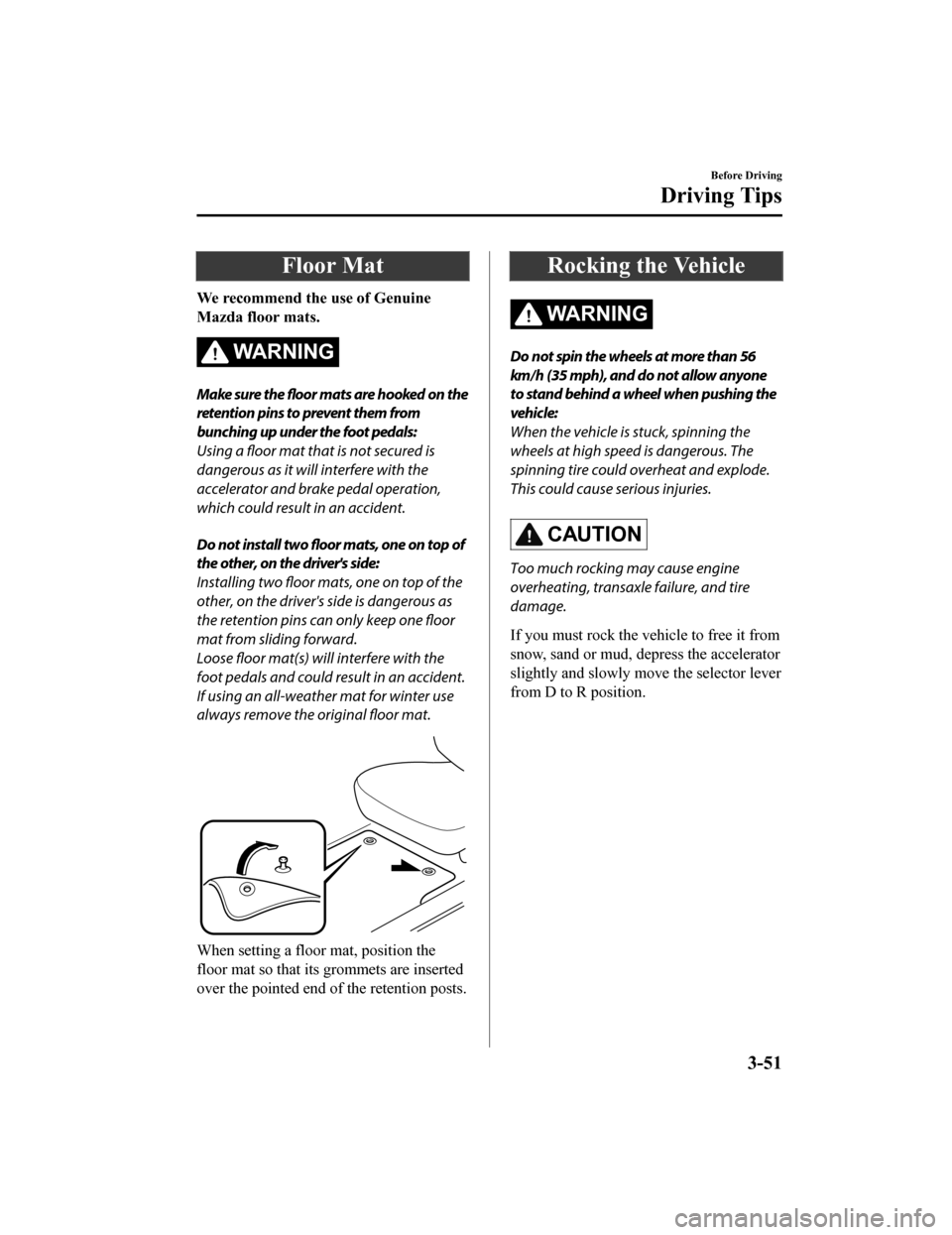
Floor Mat
We recommend the use of Genuine
Mazda floor mats.
WA R N I N G
Make sure the floor mats are hooked on the
retention pins to prevent them from
bunching up under the foot pedals:
Using a floor mat that is not secured is
dangerous as it will interfere with the
accelerator and brake pedal operation,
which could result in an accident.
Do not install two floor mats, one on top of
the other, on the driver's side:
Installing two floor mats, one on top of the
other, on the driver's side is dangerous as
the retention pins can only keep one floor
mat from sliding forward.
Loose floor mat(s) will interfere with the
foot pedals and could result in an accident.
If using an all-weather mat for winter use
always remove the original floor mat.
When setting a floor mat, position the
floor mat so that its grommets are inserted
over the pointed end of the retention posts.
Rocking the Vehicle
WA R N I N G
Do not spin the wheels at more than 56
km/h (35 mph), and do not allow anyone
to stand behind a wheel when pushing the
vehicle:
When the vehicle is stuck, spinning the
wheels at high speed is dangerous. The
spinning tire could overheat and explode.
This could cause serious injuries.
CAUTION
Too much rocking may cause engine
overheating, transaxle failure, and tire
damage.
If you must rock the vehicle to free it from
snow, sand or mud, depress the accelerator
slightly and slowly move the selector lever
from D to R position.
Before Driving
Driving Tips
3-51
CX-9_8HT8-EA-19I_Edition2_old 2019-9-24 13:14:55
Page 152 of 706

Winter Driving
Carry emergency gear, including tire
chains, window scraper, flares, a small
shovel, jumper cables, and a small bag of
sand or salt.
Ask an Authorized Mazda Dealer to check
the following:
ï‚·Have the proper ratio of antifreeze in the
radiator.
Refer to Engine Coolant on page 6-24.
ï‚·Inspect the battery and its cables. Cold
reduces battery capacity.
ï‚·Use an engine oil appropriate for the
lowest ambient temperatures that the
vehicle will be driven in (page 6-22).
ï‚·Inspect the ignition system for damage
and loose connections.
ï‚·Use washer fluid made with
antifreeze―but do not use engine
coolant antifreeze for washer fluid (page
6-26).
NOTE
ï‚·Remove snow before driving. Snow left
on the windshield is dangerous as it
could obstruct vision.
ï‚·Do not apply excessive force to a
window scraper when removing ice or
frozen snow on the mirror glass and
windshield.
ï‚·Never use warm or hot water for
removing snow or ice from windows and
mirrors as it could result in the glass
cracking.
ï‚·Drive slowly. Braking performance can
be adversely affected if snow or ice
adheres to the brake components. If this
situation occurs, drive the vehicle
slowly, releasing the accelerator pedal
and lightly applying the brakes several
times until the brake performance
returns to normal.
â–¼ Snow Tires
WA R N I N G
Use only the same size and type tires (snow,
radial, or non-radial) on all 4 wheels:
Using tires
different in size or type is
dangerous. Your vehi cle's handling could
be greatly affected and result in an
accident.
CAUTION
Check local regulations before using
studded tires.
NOTE
The tire pressure monitoring system may
not function correctly when using tires
with steel wire reinforcement in the
sidewalls (page 4-218).
Use snow tires on all 4 wheels
Do not exceed the maximum permissible
speed for your snow tires or legal speed
limits.
â–¼ Tire Chains
Check local regulations before using tire
chains.
Before Driving
Driving Tips
3-52
CX-9_8HT8-EA-19I_Edition2_old
2019-9-24 13:14:55
Page 154 of 706
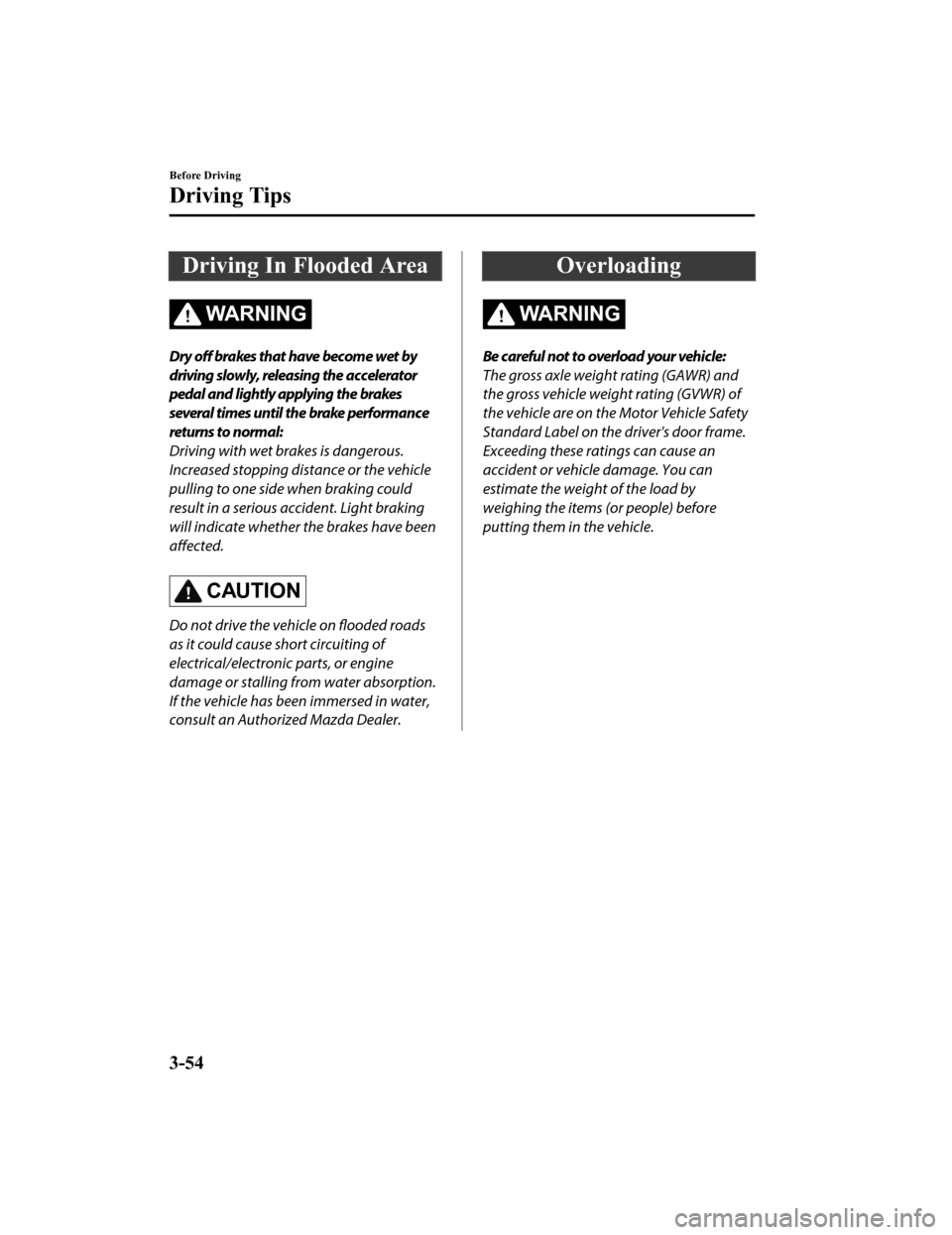
Driving In Flooded Area
WA R N I N G
Dry off brakes that have become wet by
driving slowly, releasing the accelerator
pedal and lightly applying the brakes
several times until the brake performance
returns to normal:
Driving with wet brakes is dangerous.
Increased stopping distance or the vehicle
pulling to one side when braking could
result in a serious accident. Light braking
will indicate whether the brakes have been
affected.
CAUTION
Do not drive the vehicle on flooded roads
as it could cause short circuiting of
electrical/electronic parts, or engine
damage or stalling from water absorption.
If the vehicle has been immersed in water,
consult an Authorized Mazda Dealer.
Overloading
WA R N I N G
Be careful not to overload your vehicle:
The gross axle weight rating (GAWR) and
the gross vehicle weight rating (GVWR) of
the vehicle are on the Motor Vehicle Safety
Standard Label on the driver's door frame.
Exceeding these ratings can cause an
accident or vehicle damage. You can
estimate the weight of the load by
weighing the items (or people) before
putting them in the vehicle.
Before Driving
Driving Tips
3-54
CX-9_8HT8-EA-19I_Edition2_old 2019-9-24 13:14:55
Page 160 of 706
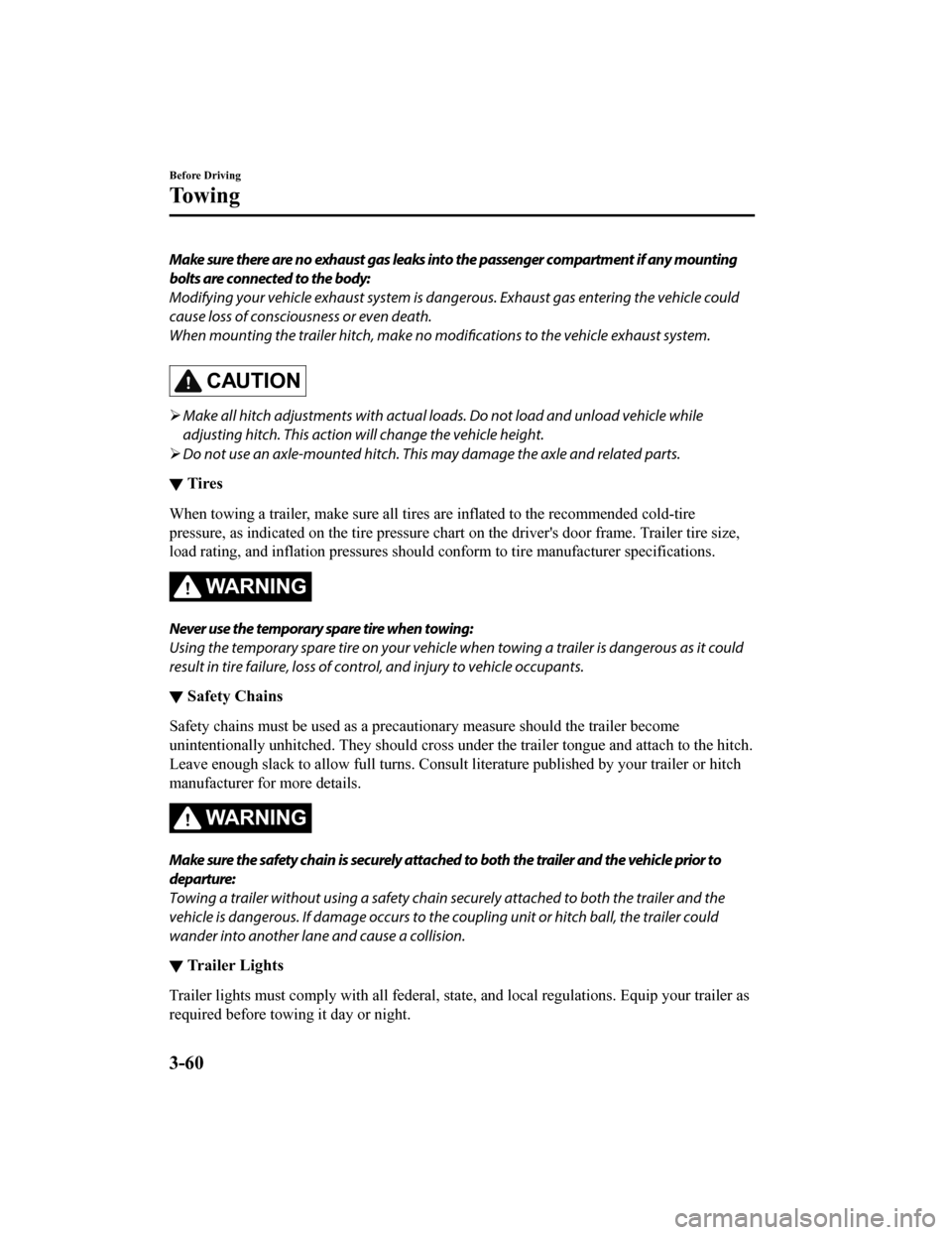
Make sure there are no exhaust gas leaks into the passenger compartment if any mounting
bolts are connected to the body:
Modifying your vehicle exhaust system is dangerous. Exhaust gas entering the vehicle could
cause loss of consciousness or even death.
When mounting the trailer hitch, make no modifications to the vehicle exhaust system.
CAUTION
Make all hitch adjustments with actual loads. Do not load and unload vehicle while
adjusting hitch. This action wi ll change the vehicle height.
 Do not use an axle-mounted hitch. This may damage the axle and related parts.
â–¼ Tires
When towing a trailer, make sure all tires
are inflated to the recommended cold-tire
pressure, as indicated on the tire pressure chart on the driver's door frame. Trailer tire size,
load rating, and inflation pr essures should conform to ti re manufacturer specifications.
WA R N I N G
Never use the temporary spare tire when towing:
Using the temporary spare tire on your vehicle wh en towing a trailer is dangerous as it could
result in tire failure, loss of control, and injury to vehicle occupants.
â–¼ Safety Chains
Safety chains must be used as a precautionary measure should the trailer become
unintentionally unhitched. They should cross un
der the trailer tongue and attach to the hitch.
Leave enough slack to allow full turns. Consult literature published by your trailer or hitch
manufacturer for more details.
WA R N I N G
Make sure the safety chain is securely attached to both the trailer and the vehicle prior to
departure:
Towing a trailer without using a safety chain securely attached to both the trailer and the
vehicle is dangerous. If damage occurs to the coupling unit or hitch ball, the trailer could
wander into another lane and cause a collision.
â–¼ Trailer Lights
Trailer lights must comply with all federal, st
ate, and local regulations. Equip your trailer as
required before towing it day or night.
Before Driving
To w i n g
3-60
CX-9_8HT8-EA-19I_Edition2_old 2019-9-24 13:14:55
Page 161 of 706
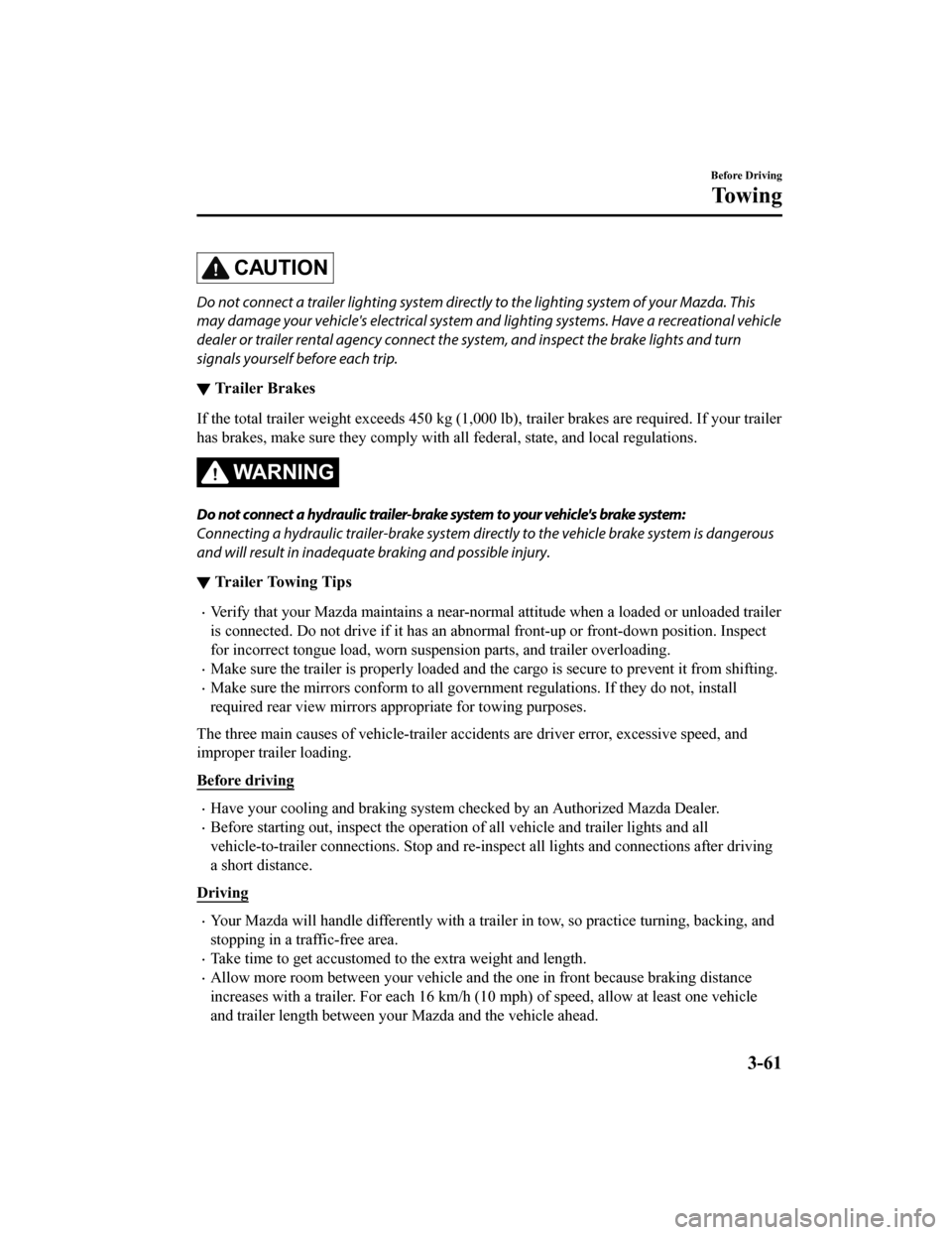
CAUTION
Do not connect a trailer lighting system directly to the lighting system of your Mazda. This
may damage your vehicle's electrical system an d lighting systems. Have a recreational vehicle
dealer or trailer rental agency connect the system, and inspect the brake lights and turn
signals yourself before each trip.
â–¼ Trailer Brakes
If the total trailer weight exceeds 450 kg (1,000 lb),
trailer brakes are required. If your trailer
has brakes, make sure they comply with all federal, state, and local regulations.
WA R N I N G
Do not connect a hydraulic trailer-brake system to your vehicle's brake system:
Connecting a hydraulic trailer-brake system direc tly to the vehicle brake system is dangerous
and will result in inadequate braking and possible injury.
â–¼ Trailer Towing Tips
ï‚·Verify that your Mazda maintains a near-normal attitude when a loaded or unloaded trailer
is connected. Do not drive if it has an abnormal front-up or front-down position. Inspect
for incorrect tongue load, worn suspension parts, and trailer overloading.
ï‚·Make sure the trailer is properly loaded and the
cargo is secure to prevent it from shifting.
ï‚·Make sure the mirrors conform to all government regulations. If they do not, install
required rear view mirrors appr opriate for towing purposes.
The three main causes of vehicle-trailer accidents are driver error, excessive speed, and
improper trailer loading.
Before driving
ï‚·Have your cooling and braking system checked by an Authorized Mazda Dealer.
ï‚·Before starting out, inspect the operation of all vehicle and trailer lights and all
vehicle-to-trailer connections. Stop and re-inspec t all lights and connections after driving
a short distance.
Driving
ï‚·Your Mazda will handle differently with a traile r in tow, so practice turning, backing, and
stopping in a traffic-free area.
ï‚·Take time to get accustomed to the extra weight and length.
ï‚·Allow more room between your vehicle and the one in front because braking distance
increases with a trailer. For each 16 km/h (10 mph) of speed, allow at least one vehicle
and trailer length between your Mazda and the vehicle ahead.
Before Driving
To w i n g
3-61
CX-9_8HT8-EA-19I_Edition2_old 2019-9-24 13:14:55
Page 162 of 706

ï‚·Avoid jerky starts or sudden acceleration.
ï‚·Avoid sudden braking. It may cause loss of control and result in jackknifing, especially so
on wet or slippery roads.
ï‚·Shift the selector lever to the D position wh en towing a trailer in hilly terrain or when
heavily loaded.
The D position will allow operating th e vehicle without frequent shifting.
Lane changes and turning
Avoid quick lane changes, sudden turns, and tight turns. Slow down before turning to avoid
the need of sudden braking.
A turning trailer will make a tighter arc than th e tow vehicle. Compensate with turns that are
larger than normal.
Passing
Plan well ahead to pass other vehicles, and provide plenty of room before changing lanes.
Crosswinds from passing vehicles, especially larger ones, and the effects of rough roads will
affect handling.
If swaying occurs, firmly grip the steering wheel and reduce speed immediately, but
gradually.
Steer straight ahead. If no extreme correc tion of steering or braking is made, the
combination of less speed and firm steering will result in stability.
Backing up
Backing a vehicle with a trailer requires practice and patience. Back slowly, and have a
helper outside at the rear of the trailer to reduce the risk of an accident.
To turn the trailer, place your hand at the bott om of the steering wheel and turn it in the
direction you want the trailer to go. Make only slight movements to prevent sharp or
prolonged turning.
Ascending a hill
Shift into a lower gear to redu ce the possibility of overloading or overheating the engine, or
both.
Descending a hill
Shift into a lower gear and use engine compression as a braking effect.
Before Driving
To w i n g
3-62
CX-9_8HT8-EA-19I_Edition2_old 2019-9-24 13:14:55
Page 167 of 706

4When Driving
Information concerning safe driving and stopping.
Start/Stop Engine.............................. 4-4 Ignition Switch........ ..................... 4-4
Starting the Engine....................... 4-6
Turning the Engine Off...............4-10
Instrument Cluster and Display ............
........................................................... 4-12 Instrument Cluster and
Display........................................4-12
Instrument Cluster (Type A)....... 4-13
Instrument Cluster (Type B)....... 4-30
Instrument Cluster (Type C)....... 4-45
Active Driving Display
*............. 4-56
Automatic Transaxle....................... 4-59 Automatic Transaxle
Controls...................................... 4-59
Shift-Lock System...................... 4-60
Transaxle Ranges........................4-60
Manual Shift Mode..................... 4-62
Driving Tips................................4-67
Switches and Controls..................... 4-68
Lighting Control......................... 4-68
Fog Lights
*................................. 4-73
Turn and Lane-Change
Signals........................................ 4-73
Windshield Wipers and
Washer........................................ 4-74
Rear Window Wiper and
Washer........................................ 4-78
Rear Window Defogg er.............. 4-78
Horn............................................ 4-80
Hazard Warning Flasher............. 4-80
HomeLink Wireless Control System
(Type A)
*.................................... 4-81
HomeLink Wireless Control System
(Type B)...................................... 4-84
Brake................................................ 4-89 Brake System.............................. 4-89
AUTOHOLD.............................. 4-93
Hill Launch Assist (HLA).......... 4-97
ABS/TCS/DSC/Trailer Stability
Control (TSC)/Off-Road Traction
Assist................................................. 4-99 Antilock Brake System
(ABS)..........................................4-99
Traction Control System
(TCS)........................................ 4-100
Dynamic Stability Control
(DSC)........................................4-102
Trailer Stability Control
(TSC)........................................ 4-103
Off-Road Traction Assist
*........ 4-104
*Some models.4-1
CX-9_8HT8-EA-19I_Edition2_old 2019-9-24 13:14:55
Page 168 of 706

Fuel Economy Monitor................. 4-106Fuel Economy Monitor............ 4-106
Drive Selection............................... 4-109 Drive Selection......................... 4-109
i-ACTIV AWD................................4-111 i-ACTIV AWD Operation
*....... 4-111
Power Steering............................... 4-113 Power Steering..........................4-113
i-ACTIVSENSE............................. 4-114
i-ACTIVSENSE
*...................... 4-114
Adaptive Front Lighting System
(AFS)
*.......................................4-117
High Beam Control System
(HBC)
*...................................... 4-118
Blind Spot Monitoring (BSM)
*.........
.................................................. 4-121
Traffic Sign Recognition System
(TSR)
*...................................... 4-127
Distance Recognition Support
System (DRSS)
*....................... 4-133
Rear Cross Traffic Alert (RCTA)
*.....
.................................................. 4-137
Mazda Radar Cruise Control with
Stop & Go function (MRCC with
Stop & Go function)
*............... 4-141
Lane-keep Assist System (LAS) &
Lane Departure Warning System
(LDWS)
*.................................. 4-156
Advanced Smart City Brake Support
(Advanced SCBS)
*...................4-167
Smart City Brake Support
(SCBS)
*.................................... 4-170
Smart Brake Support (SBS)
*.... 4-173
360° View Monitor
*................. 4-175
Forward Sensing Camera (FSC)
*......
.................................................. 4-201
Radar Sensor (Front)
*.............. 4-206
Radar Sensors (Rear)
*.............. 4-209
Front Camera/Side Cameras/Rear
Camera
*.................................... 4-211
Cruise Control............................... 4-212 Cruise Control
*.........................4-212
4-2*Some models.
CX-9_8HT8-EA-19I_Edition2_old 2019-9-24 13:14:55
Page 170 of 706
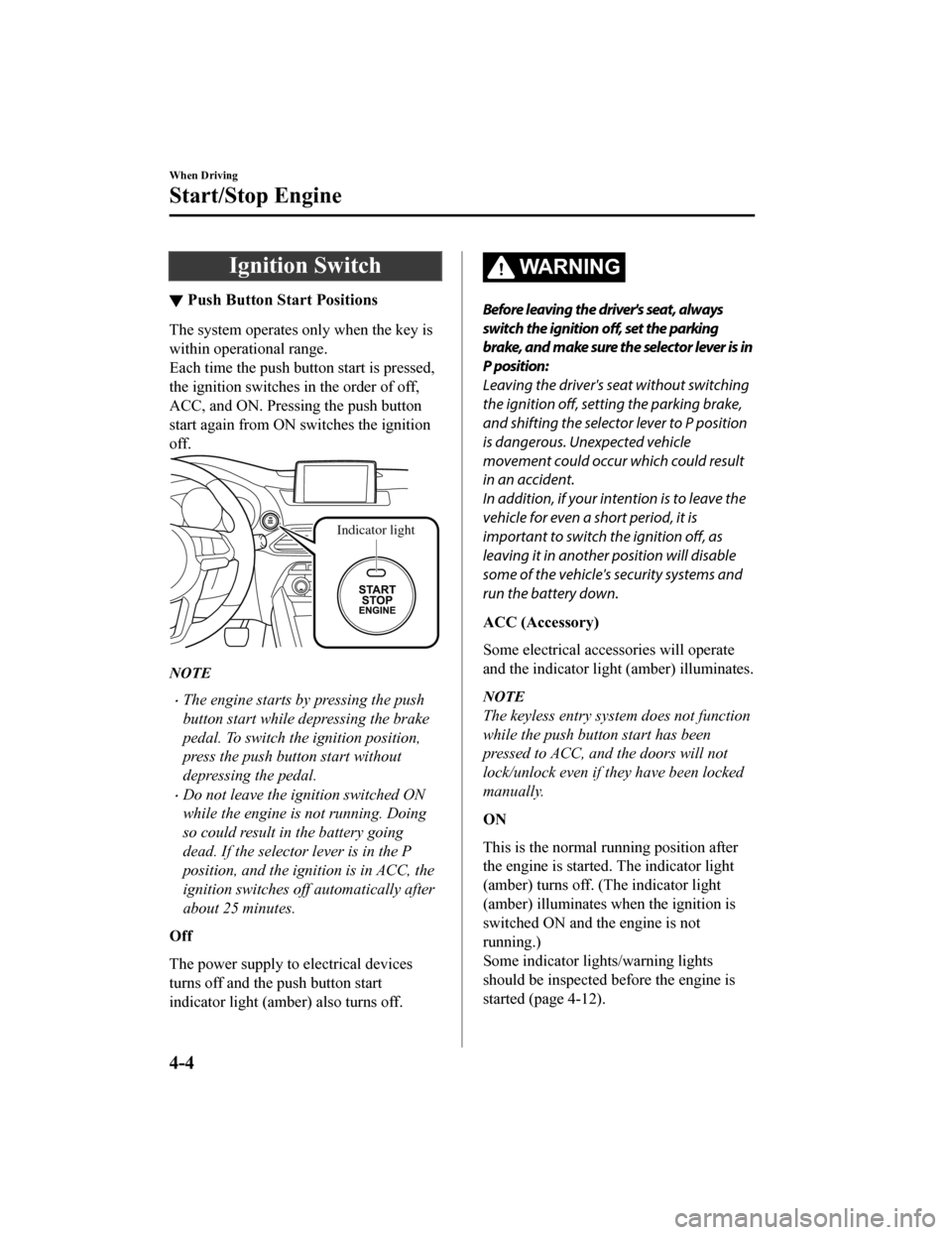
Ignition Switch
â–¼Push Button Start Positions
The system operates only when the key is
within operational range.
Each time the push button start is pressed,
the ignition switches in the order of off,
ACC, and ON. Pressing the push button
start again from ON switches the ignition
off.
Indicator light
NOTE
ï‚·The engine starts by pressing the push
button start while depressing the brake
pedal. To switch the ignition position,
press the push button start without
depressing the pedal.
ï‚·Do not leave the ignition switched ON
while the engine is not running. Doing
so could result in the battery going
dead. If the selector lever is in the P
position, and the ignition is in ACC, the
ignition switches off automatically after
about 25 minutes.
Off
The power supply to electrical devices
turns off and the push button start
indicator light (amber) also turns off.
WA R N I N G
Before leaving the driver's seat, always
switch the ignition off, set the parking
brake, and make sure the selector lever is in
P position:
Leaving the driver's seat without switching
the ignition off, setting the parking brake,
and shifting the selector lever to P position
is dangerous. Unexpected vehicle
movement could occur which could result
in an accident.
In addition, if your intention is to leave the
vehicle for even a short period, it is
important to switch the ignition off, as
leaving it in another position will disable
some of the vehicle's security systems and
run the battery down.
ACC (Accessory)
Some electrical accessories will operate
and the indicator light (amber) illuminates.
NOTE
The keyless entry system does not function
while the push button start has been
pressed to ACC, and the doors will not
lock/unlock even if they have been locked
manually.
ON
This is the normal running position after
the engine is started. The indicator light
(amber) turns off. (The indicator light
(amber) illuminates wh en the ignition is
switched ON and the engine is not
running.)
Some indicator lights/warning lights
should be inspected before the engine is
started (page 4-12).
When Driving
Start/Stop Engine
4-4
CX-9_8HT8-EA-19I_Edition2_old 2019-9-24 13:14:55
Page 172 of 706
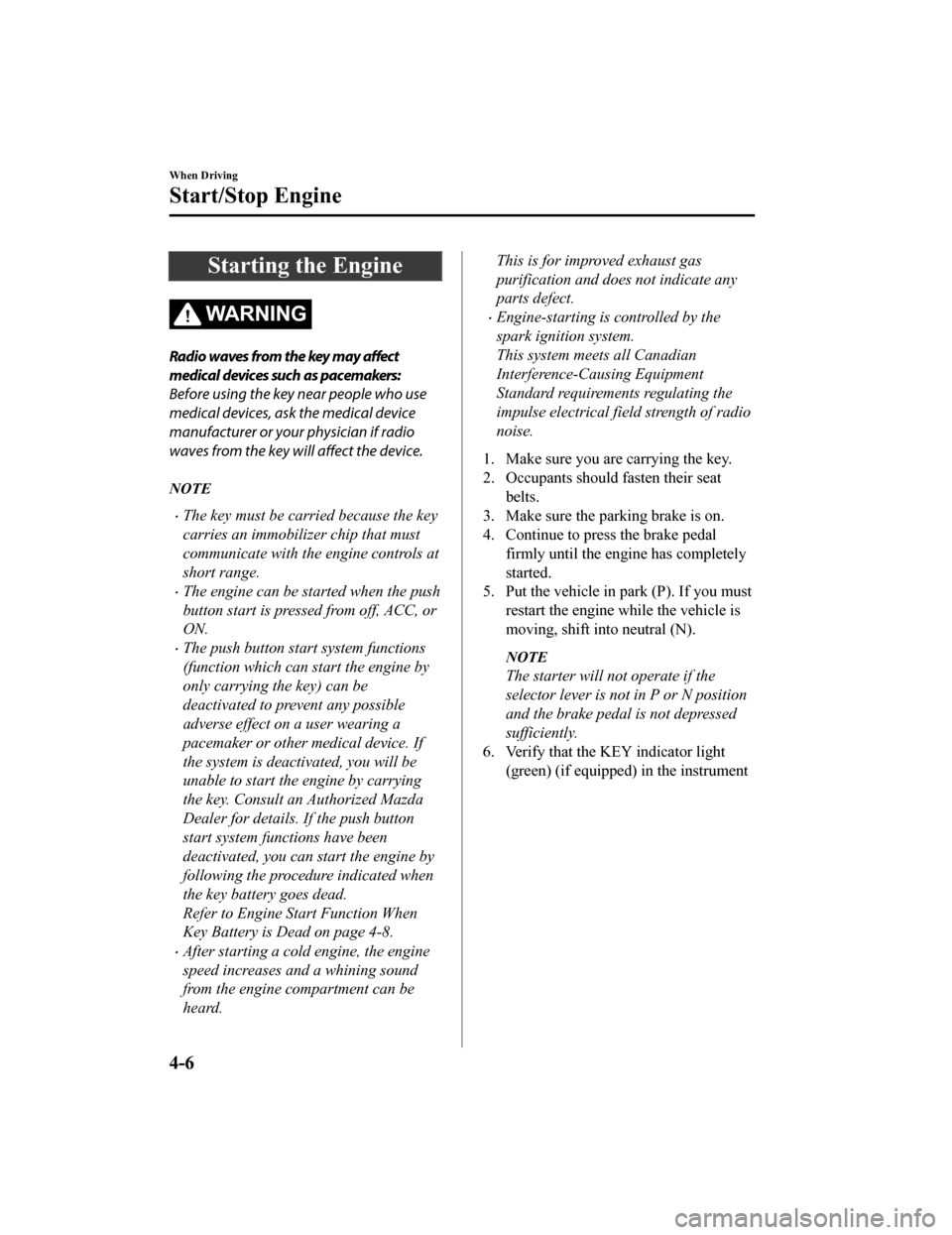
Starting the Engine
WA R N I N G
Radio waves from the key may affect
medical devices such as pacemakers:
Before using the key near people who use
medical devices, ask the medical device
manufacturer or your physician if radio
waves from the key will affect the device.
NOTE
ï‚·The key must be carried because the key
carries an immobilizer chip that must
communicate with the engine controls at
short range.
ï‚·The engine can be started when the push
button start is pressed from off, ACC, or
ON.
ï‚·The push button start system functions
(function which can start the engine by
only carrying the key) can be
deactivated to prevent any possible
adverse effect on a user wearing a
pacemaker or other medical device. If
the system is deactivated, you will be
unable to start the engine by carrying
the key. Consult an Authorized Mazda
Dealer for details. If the push button
start system functions have been
deactivated, you can start the engine by
following the procedure indicated when
the key battery goes dead.
Refer to Engine Start Function When
Key Battery is Dead on page 4-8.
ï‚·After starting a cold engine, the engine
speed increases and a whining sound
from the engine compartment can be
heard.
This is for improved exhaust gas
purification and does not indicate any
parts defect.
ï‚·Engine-starting is controlled by the
spark ignition system.
This system meets all Canadian
Interference-Causing Equipment
Standard requirements regulating the
impulse electrical field strength of radio
noise.
1. Make sure you are carrying the key.
2. Occupants should fasten their seat belts.
3. Make sure the parking brake is on.
4. Continue to press the brake pedal firmly until the en gine has completely
started.
5. Put the vehicle in park (P). If you must
restart the engine while the vehicle is
moving, shift into neutral (N).
NOTE
The starter will not operate if the
selector lever is not in P or N position
and the brake pedal is not depressed
sufficiently.
6. Verify that the KEY indicator light (green) (if equipped) in the instrument
When Driving
Start/Stop Engine
4-6
CX-9_8HT8-EA-19I_Edition2_old 2019-9-24 13:14:55